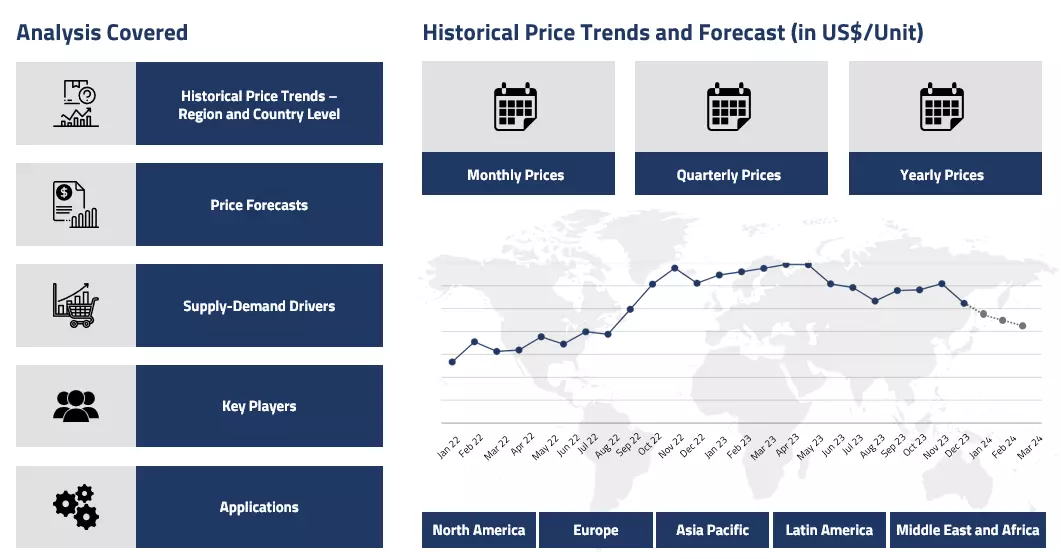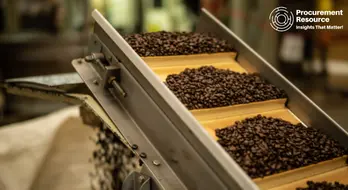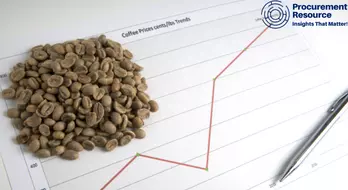Product
Coffee Price Trend and Forecast
Coffee Price Trend and Forecast
Coffee Regional Price Overview
Get the latest insights on price movement and trend analysis of Coffee in different regions across the world (Asia, Europe, North America, Latin America, and the Middle East & Africa).
Coffee Price Trend for the Second Half of 2024
In the second half of 2024, coffee prices exhibited an oscillating trajectory, remaining at historically high levels globally. The upward trend was primarily driven by supply constraints amid rising global demand. Adverse weather conditions, particularly in Brazil, disrupted coffee production. As the world's largest coffee producer, Brazil faced supply challenges, limiting global availability and contributing to elevated prices.
Coffee Price Chart

Please Login or Subscribe to Access the Coffee Price Chart Data
Additionally, prolonged drought conditions during the summer months severely affected production, as coffee plants are highly sensitive to climatic changes. Although favorable monsoon rains later in the year triggered flowering, uncertainty regarding the upcoming harvest kept market sentiment elevated. Overall, coffee prices remained on an upward trend throughout the quarter, influenced by production declines and supply disruptions.
Analyst Insight
According to Procurement Resource, the prices of coffee are expected to witness a similar trajectory influenced by supply disruptions in the upcoming months as well as cold weather conditions may pose some logistical challenges.
Coffee Price Trend for the First Half of 2024
In the first half of 2024, coffee prices exhibited a significant upward trend, driven by a combination of supply challenges and rising demand. Robusta prices surged to record highs due to a severe drought in Vietnam, the largest producer of robusta coffee, which led to crop damage and a projected production decline to the lowest level in 13 years. Similarly, arabica prices were influenced by drier-than-average conditions in Brazil, particularly in the key coffee-growing region of Minas Gerais. Global supply disruptions, such as the lower exports from Vietnam and Costa Rica, further supported the price rally, while Central America also faced moisture deficits despite some rainfall recovery.
Despite these bullish factors, coffee inventories began to rebound after hitting historic lows in late 2023, easing some supply concerns. Despite the pressures from increasing inventories and expected production growth, the coffee market's overall trajectory remained upward in H1'24, reflecting tight supply conditions and sustained global demand, particularly for robusta, which saw an approximate 63% price increase driven by roasters switching from the more expensive arabica to the cheaper robusta bean.
Analyst Insight
According to Procurement Resource, Coffee consumption is on the rise globally, therefore, coffee prices are not expected to come down in the immediate future; the market will take some time to ease down.
Coffee Price Trend for the Second Half of 2023
Coffee prices were observed to be oscillating throughout the said period of the second half of the year 2023. Quarter three began on a rather balanced note as the prices were observed to be wavering within a very limited range. However, the final quarter saw a substantial upswing in the coffee prices. The unseasonal weather disruptions curtailed the supplies and thus prompted the prices up.
Demands were consistently rising, even more in the winter months. A labor shortage created more problems for suppliers amidst a fallen production yield. The Indian coffee market saw around 16% inflation in the month of December’23. A rapid rise in the Indian domestic markets subdued the available export volumes. Overall, a positive market performance was witnessed.
Analyst Insight
According to Procurement Resource, the Coffee price trends are expected to rise even further in the coming months as both the upstream and downstream factors look supportive of the market trend.
Coffee Price Trend for the First Half of 2023
During the first half of the year 2023, coffee prices soared across the world as a supply constraint was observed amidst consistent end-consumer demands. The continuous lower production yields in 3 consecutive years were primarily responsible for this upsurge in Coffee prices.
In Brazilian coffee farms, not only was the yield reduced, but the adverse weather conditions called for a delayed harvest, which further raised quality concerns. In Feb’23, the prices jumped as high as 6% within a single week for some varieties of coffee. Overall, the Coffee prices remained on an inclined trajectory throughout the said period.
Analyst Insight
According to Procurement Resource, the price trend for Coffee are likely to rise further as the uneven and disturbed rain cycle this year has impacted the farm yields, and the inventories are also emptying rapidly. Thus, the Coffee prices will incline in the upcoming months.
Coffee Price Trend for the Fourth Quarter of 2022
After surging all through the first three quarters, the Coffee prices stabilized a little in the final quarter. The Russia and Ukraine conflict and Chinese lockdown earlier in the year crumbled the supply chains, and various shipments got stuck in the middle of a commute.
The decline in prices came as a result of the restored movement in these stuck shipments. The bad weather conditions continued to affect the coffee yields in the African sub-continents, but as the supply chains were restored and newer trade routes opened up, the prices declined marginally in the final quarter of the year 2022.
Analyst Insight
According to Procurement Resource, with continuously declining farm yields of coffee beans, the prices are projected to rise in the upcoming months.
Coffee Price Trend for the Third Quarter of 2022
Asia
The price trend for coffee registered an upwards trajectory in Q3 throughout the Asia-Pacific region. In India, the prices of raw Robusta coffee berries reached a whopping 106 INR/kg compared to the 80 INR/kg value during the same period the previous year. These high prices were due to the short supply of coffee beans in the market owing to the harvest losses amid adverse climates.
Incessant rainfall, -flooding, caused delays in the flowering season which affected the overall rates of production and exports. Vietnam the largest producer of Robusta beans witnessed a slump of 15-17 per cent in exports. The inventories of Arabica coffee witnessed a 23% decrease in overall production.
However, as the international situation stabilized coffee prices began to dwindle in the fourth quarter. A combination of overly optimistic flowering season and weaker economic conditions caused the demand and hence the prices to fall.
Latin America
Owing to the harvest losses in Brazil and Columbia (due to La Nina), the prices inclined worldwide as severe supply constraints were created. The lowered supply and rising demand caused the price trend for coffee to incline drastically. The price of Brazilian Naturals went from 214.80 US cents/lb to 221.91 US cents/lb and that of Columbian Milds went from 286.07 US cents/lb to 295.66 US cents/lb towards the end of Q3.
However, soon the prices came under pressure as the demand started falling. With the central banks hiking interest rates worldwide, it directly affected the purchasing power of people leading to a fall in demand. Hence, the price of Brazilian Naturals went from 192.27 US cents/lb to 169 USD cents/lb while that of Columbian Milds went from 261.95 US cents/lb to 224.12 US cents/lb towards the end of Q4.
Analyst Insight
According to Procurement Resource, the price of coffee will remain under pressure for an extended period. However, while yields are expected to increase for some of the world’s largest coffee-producing countries, farmers are also facing rising costs of production. Hence, these rising costs will keep prices from tumbling too sharply rather than not falling or rallying back up.
Coffee Price Trend For the Second Quarter of 2022
Asia
Despite the ongoing European conflict, the prices and consumption of coffee are rising globally. According to the International Coffee Organization, Composite Indicator Price, the commodity gained around 4.5% from May to June 2022, with a global average of 202.46 US cents/lb.
The prices of Vietnam coffee are constantly rising as the domestic supplies are running low, and the traders are finding it hard to secure enough to meet their export quotas. The price of COFUN-DAK went from 1.88-1.90 USD/kg in the said quarter.
The price of the Robusta coffee averaged 1981 USD/MT, recording an increase of almost 1.4%. The prices will likely remain strong until the farmers start the new harvest in November-December.
North America
The prices in the US domestic arena remained strong in this quarter. The prices averaged 7.3-7.29 USD/kg in the domestic market. The US coffee cost was around USD 7299.33 in New York and Washington.
Latin America
The price of Brazilian Naturals averaged 230.40 US cents/lb, and that of Colombian Milds increased to 301.57 US cents/lb. However, volatility was seen in the price trend of Brazilian Naturals due to the lower supplies from Brazil.
Minas Gerais, an area which accounts for almost 30% of Brazil’s coffee production, received significantly less rainfall disrupting the supply of coffee beans. Hence, due to the tight inventories, the prices increased in the market.
Coffee Price Trend For the First Quarter of 2022
Asia
Following a decline in London prices due to interruptions in supply chains and payment systems, as well as increased oil prices as a result of the recent Russia-Ukraine conflict, domestic coffee prices in Vietnam fell in the first quarter. Farmers in Vietnam's Central Highlands, the country's largest coffee-growing region, sold coffee COFVN-DAK for 38,900-41,000 VND/kg (1.70-1.80 USD) in the first week of March, down from 40,600-41,800 VND/kg the previous week.
Europe
Germany continued to be the largest consumer of Vietnamese coffee, accounting for 18.4% of total volume and 17.5% of total export turnover, with 30,086 tons, equivalent to USD 64.71 million, at an average price of 2,151 USD/MT compared to December 2021.
Belgian exports ranked second in terms of volume and turnover, accounting for 14.6% of total volume and 12.5% of total coffee export turnover, with 23,877 tons, equivalent to USD 46.18 million, at an average price of 1,934 USD/MT, a decrease of 9% in price, compared to December 2021.
North America
Coffee prices increased in January 2022, hitting 204.29 US cents/lb, continuing the upward trend begun in 2021. The intra-day volatility of the ICO composite indicator price dropped by 1.8 percentage points to 8.3 percent in January 2022. The arbitrage between Arabica and Robusta coffees climbed by 3.9% to 135.07 US cents/lb, as assessed on the New York and London futures markets.
Arbitrage between the two futures markets has quadrupled in a year, from 67.05 US cents/lb in January 2021 to 135.07 US cents/lb in January 2022. Certified stocks on major coffee markets continued to decrease, plunging 16.2% in New York and 5.4% in London, respectively.
Latin America
From December 2021 to January 2022, the largest price increases were in the Colombian Mild and Brazilian Naturals classes, which averaged 294.93 US cents/lb and 233.80 US cents/lb, respectively. This marked a 1.5% gain for both groups over the earlier month's figures of 290.57 US cents/lb and 230.26 US cents/lb, respectively.
During January 2022, prices for Other Mild grew by 1.3% to 271.08 US cents/lb, up from 267.71 US cents/lb the previous month. Robusta, which was priced at 109.71 US cents/lb in January 2022, dropped 2.7% in the earlier month.
Coffee Price Trend For the Fourth Quarter of 2021
Asia
Indian exports increased by 28% in 2021, owing to a rebound in demand in the world's largest coffee-consuming countries in the second half of the year. Exporters are hesitant to match it in 2022, owing to the fear surrounding the current variant of COVID-19.
Karnataka is India's largest coffee grower, accounting for over 70% of national production. Meanwhile, the Kerala government chose to purchase this commodity from marginal farmers in Wayanad, the state's primary coffee producing region, at a premium of 10 INR/kg over market prices. Kerala is the country's second largest coffee grower. The state government also budgeted INR 50 lakh for the acquisition of 455 MT of the produce.
North America
Coffee prices have risen to a 10-year high, and economists predict that market tightness will last until 2023. Contracts for December delivery were trading at 2.34 USD/lb on Monday. Futures on the New York Intercontinental Exchange hit 2.46 USD on Thursday, the highest price since the commodity broke above 3 USD/lb in 2011. Meanwhile, the benchmark price set by the International Coffee Association was 2.07 USD/lb, up 85% from a year ago.
Latin America
According to data produced by the National Institute of Statistics and Geography (INEGI) at the end of November, typical coffee prices from brands like as Nescafé, Legal, and Starbucks did not reflect the increase witnessed in Arabica contracts, which are primarily exported from Brazil and Colombia. Others, such as the average price of a 500-gram bag of normal coffee from Punta de Cielo, increased by 20.13% from November of last year to November of 2021.
Droughts followed by harsh frosts in Brazil, which produces one-third of the world's coffee, were responsible for a surge in its prices. According to Conab, a crop forecasting agency, producers gathered over 40% less arabica coffee, the world's most consumed type, than they did last year. Meanwhile, in Colombia, the second-largest exporter of arabica, heavy rains wreaked havoc on fields. Supply chain issues, such as port congestion or a shortage of personnel along with rising energy costs, which affect fertiliser prices, also led to higher coffee prices.
Coffee Price Trend For the First, Second, and Third Quarters of 2021
Asia
Indian coffee prices commodity are highly correlated with world pricing, as around two-thirds of the country's three lakh tonnes of coffee is exported. Over the last four months, the premium that Indian arabica parchment commands over the New York ICE terminal has nearly halved to 30-37 cents per pound over the terminal, down from 60-65 cents in mid-December. Similarly, LIFFE has reduced the premium for robusta parchment by half.
Farm gate coffee prices in Karnataka had fallen by 6-7% over the last four months, despite the fact that global prices remained unpredictable. Arabica May 21 futures on ICE increased to 132 cents per pound, up from around 128 cents in early April. Similarly, LIFFE's May 21 Robusta futures were hovering around at 1,365 USD/MT, up from 1,350 USD/MT in early April.
North America
In August 2021, the average price of New York traded Arabica beans grew to 2.03 USD/lb, a 66% gain since the end of 2020. Futures prices surged as a result of predicted crop losses in Brazil, the world's largest coffee grower and exporter. According to USDA predictions, severe droughts in Brazil might cut the 2020-2021 Arabica coffee harvest by 30% compared to the previous market year and by 23% compared to the 2017-2021 average.
Increasing sea fright prices also contributed to rise in coffee prices. Brazil produces 40% of Arabica coffee beans and exports 27% of the world's coffee beans. It provides 30% of the coffee beans imported by the United States.
Latin America
The Brazilian naturals indication saw the largest price increase, reaching 174.89 US cents/lb in August 2021, up 8.9% from 160.62 US cents/lb in July 2021. Brazilian Naturals' average monthly price was at an all-time high of 181.43 US cents. The price of Colombian Milds climbed by 3.1% to 225.40 US cents. In August, the price was 218.66 US cents/lb, down from 218.66 US cents/lb in July 2021.
The monthly average recorded by the Colombian Milds in August 2021 was the highest since the level in February 2012, when a price of 244.14 US cents/lb was recorded. It also indicated a 46.1% increase over the previous level. In October 2020, 154.28 cents/lb was recorded.
Coffee Price Trend For the Year 2020
Asia
According to the board's final projections, India's total production of the commodity between 2020 and 2021 was 3.69 lakh tonnes, with 2.35 lakh tonnes of Robusta. A little more than 1.64 lakh tonnes were shipped out of this total. The average price of the commodity in India was 2400 USD/MT, recording a high of 4300 USD/MT in May.
Europe
Its consumption per capita increased to 168 litres in 2020. Coffee drinking at home is credited with the good trend. Last year, there was an increase of roughly 11% (+ 37,900 tonnes of roasted coffee). In the same time span, consumption in gastronomy, at work, and outside of one's own four walls declined by 23%. (- 30,300 tonnes of roasted coffee). Domestic consumption growth more than outweighed the declines in the out-of-home coffee market.
Latin America
During the 2020/2021 campaign, both Arabica and Robusta coffee harvests were lower than predicted. As a result, its inventories decreased, and stock prices increased. Throughout the year, the price of Arabica coffee hovered around 1.2 USD/lb, with the lowest prices being 1.1 USD/lb.
Climate change was one of factors hurting worldwide output of the commodity, which contributed to the fall in stockpiles. Brazil endured severe droughts in 2020, which harmed Arabica coffee plantations. This sparked panic, as analysts estimated that the Brazilian harvest may be reduced by 15 to 20 MMT.
Procurement Resource provides the latest prices of Coffee. Each price database is tied to a user-friendly graphing tool dating back to 2014, which provides a range of functionalities: configuration of price series over user defined time period; comparison of product movements across countries; customisation of price currencies and unit; extraction of price data as excel files to be used offline.
About Coffee
Coffee is a well-known brewed drink that is produced from roasted coffee beans. These coffee beans are the seeds of berries belonging to certain Coffea species. It is darkly colored, bitter, moderately acidic, and has a stimulating effect in humans as it is a rich source of caffeine. As it has become one of the most popular drinks in the world, coffee plants are now cultivated in over 70 countries, mainly in the equatorial regions of the Americas, Southeast Asia, the Indian subcontinent, and Africa.
Coffee Product Details
| Report Features | Details |
| Product Name | Coffee |
| Supplier Database | Starbucks Coffee Company, Nestlé SA, Unilever, Chameleon Cold-Brew, Kohana Coffee, High Brew Coffee |
| Region/Countries Covered | Asia Pacific: China, India, Indonesia, Pakistan, Bangladesh, Japan, Philippines, Vietnam, Iran, Thailand, South Korea, Iraq, Saudi Arabia, Malaysia, Nepal, Taiwan, Sri Lanka, UAE, Israel, Hongkong, Singapore, Oman, Kuwait, Qatar, Australia, and New Zealand Europe: Germany, France, United Kingdom, Italy, Spain, Russia, Turkey, Netherlands, Poland, Sweden, Belgium, Austria, Ireland Switzerland, Norway, Denmark, Romania, Finland, Czech Republic, Portugal, and Greece North America: United States and Canada Latin America: Brazil, Mexico, Argentina, Columbia, Chile, Ecuador, and Peru Africa: South Africa, Nigeria, Egypt, Algeria, Morocco |
| Currency | US$ (Data can also be provided in local currency) |
| Supplier Database Availability | Yes |
| Customization Scope | The report can be customized as per the requirements of the customer |
| Post-Sale Analyst Support | 360-degree analyst support after report delivery |
Note: Our supplier search experts can assist your procurement teams in compiling and validating a list of suppliers indicating they have products, services, and capabilities that meet your company's needs.
Coffee Production Process
- Production of Coffee from Coffee Beans
Coffee beans are turned into a beverage in a process consisting of four basic steps. First, the coffee beans are roasted, which are then ground. The ground coffee is then combined with hot water, that is, brewed, and finally the liquid Coffee is separated from the used grounds. Although, at homes, it is generally prepared from already roasted, or already roasted and ground beans.
Methodology
The displayed pricing data is derived through weighted average purchase price, including contract and spot transactions at the specified locations unless otherwise stated. The information provided comes from the compilation and processing of commercial data officially reported for each nation (i.e. government agencies, external trade bodies, and industry publications).
Assistance from Experts
Procurement Resource is a one-stop solution for businesses aiming at the best industry insights and market evaluation in the arena of procurement. Our team of market leaders covers all the facets of procurement strategies with its holistic industry reports, extensive production cost and pre-feasibility insights, and price trends dynamics impacting the cost trajectories of the plethora of products encompassing various industries. With the best analysis of the market trends and comprehensive consulting in light of the best strategic footstep, Procurement Resource got all that it takes.
Client's Satisfaction
Procurement Resource has made a mark for itself in terms of its rigorous assistance to its clientele. Our experienced panel of experts leave no stone unturned in ensuring the expertise at every step of our clients' strategic procurement journey. Our prompt assistance, prudential analysis, and pragmatic tactics considering the best procurement move for industries are all that sets us apart. We at Procurement Resource value our clients, which our clients vouch for.
Assured Quality
Expertise, judiciousness, and expedience are the crucial aspects of our modus operandi at Procurement Resource. Quality is non-negotiable, and we don't compromise on that. Our best-in-class solutions, elaborative consulting substantiated by exhaustive evaluation, and fool-proof reports have led us to come this far, making us the ‘numero uno' in the domain of procurement. Be it exclusive qualitative research or assiduous quantitative research methodologies, our high quality of work is what our clients swear by.
Related News
Table Of Contents
Our Clients

Get in Touch With Us

UNITED STATES
Phone:+1 307 363 1045

INDIA
Phone: +91 8850629517

UNITED KINGDOM
Phone: +44 7537 171117
Email: sales@procurementresource.com





